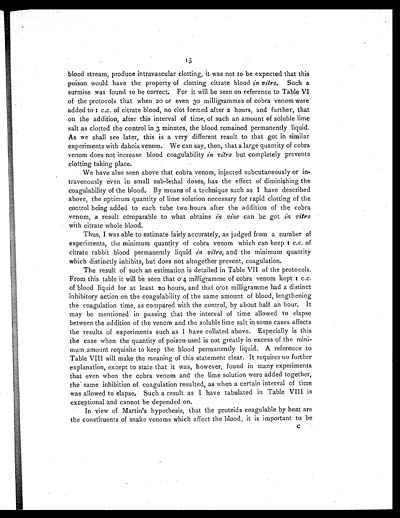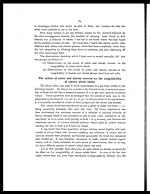Medicine - Institutions > Army health reports and medical documents > Scientific memoirs by officers of the Medical and Sanitary Departments of the Government of India > Number 4 - On the action of the venoms of the cobra (Naja tripudians) and of the daboia (Daboia russellii) on the red blood corpuscles and on the blood plasma > On the action of the venoms of the cobra (Naja tripudians) and of the daboia (Daboia russellii) on the red blood corpuscles and on the blood plasma
(21) Page 15
Download files
Individual page:
Thumbnail gallery: Grid view | List view

15
blood stream, produce intravascular clotting, it was not to be expected that this
poison would have the property of clotting citrate blood in vitro. Such a
surmise was found to be correct. For it will be seen on reference to Table VI
of the protocols that when 20 or even 30 milligrammes of cobra venom were
added to 1 c.c. of citrate blood, no clot formed after 2 hours, and further, that
on the addition, after this interval of time, of such an amount of soluble lime
salt as clotted the control in 3 minutes, the blood remained permanently liquid.
As we shall see later, this is a very different result to that got in similar
experiments with daboia venom. We can say, then, that a large quantity of cobra
venom does not increase blood coagulability in vitro but completely prevents
clotting taking place.
We have also seen above that cobra venom, injected subcutaneously or in-
travenously even in small sub-lethal doses, has the effect of diminishing the
coagulability of the blood. By means of a technique such as I have described
above, the optimum quantity of lime solution necessary for rapid clotting of the
control being added to each tube two hours after the addition of the cobra
venom, a result comparable to what obtains in vivo can be got in vitro
with citrate whole blood.
Thus, I was able to estimate fairly accurately, as judged from a number of
experiments, the minimum quantity of cobra venom which can keep 1 c.c. of
citrate rabbit blood permanently liquid in vitro, and the minimum quantity
which distinctly inhibits, but does not altogether prevent, coagulation.
The result of such an estimation is detailed in Table VII of the protocols.
From this table it will be seen that 0.4 milligramme of cobra venom kept 1 c.c.
of blood liquid for at least 20 hours, and that 0·01 milligramme had a distinct
inhibitory action on the coagulability of the same amount of blood, lengthening
the coagulation time, as compared with the control, by about half an hour. It
may be mentioned in passing that the interval of time allowed to elapse
between the addition of the venom and the soluble lime salt in some cases affects
the results of experiments such as I have collated above. Especially is this
the case when the quantity of poison used is not greatly in excess of the mini-
mum amount requisite to keep the blood permanently liquid. A reference to
Table VIII will make the meaning of this statement clear. It requires no further
explanation, except to state that it was, however, found in many experiments
that even when the cobra venom and the lime solution were added together,
the same inhibition of coagulation resulted, as when a certain interval of time
was allowed to elapse. Such a result as I have tabulated in Table VIII is
exceptional and cannot be depended on.
In view of Martin's hypothesis, that the proteids coagulable by heat are
the constituents of snake venoms which affect the blood, it is important to be
C
Set display mode to: Large image | Zoom image | Transcription
Images and transcriptions on this page, including medium image downloads, may be used under the Creative Commons Attribution 4.0 International Licence unless otherwise stated. ![]()
| Permanent URL | https://digital.nls.uk/75023936 |
|---|




